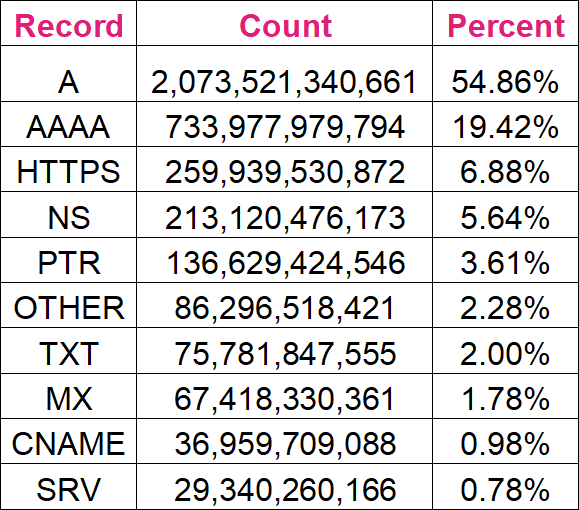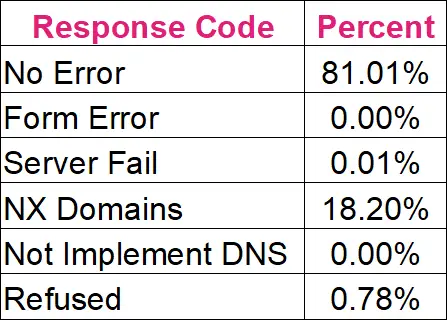When it comes to the internet, there are few elements as important as the Domain Name System (DNS). By translating domain names into IP addresses, DNS enables browsers to load internet resources and makes the internet experience we’ve come to know and love possible.
However, because DNS resolution enables us to navigate the internet, it is a prime target for bad actors. This is why the team at Vercara has not only developed our DNS solutions, UltraDNS and UltraDNS2 but also keeps a close eye on the DNS data we extract from our platform to identify emerging trends.
DNS stats for January 2024
In January, we saw over 3.78 trillion DNS queries, highlighting the crucial role that UltraDNS plays in the internet’s infrastructure.
If we examine the types of records that were queried, we can observe an intriguing pattern. The ‘A’ records, which are essentially the internet address book used to map domain names to IPv4 addresses, represented a staggering 54.86% of all the queries. This indicates that IPv4 still holds a dominant position, but we must also recognize the significance of 19.42% of ‘AAAA’ queries for IPv6 addresses. This is a clear indication of the ongoing shift towards IPv6 adoption, which we must prepare for in our network strategies.
Top Queried DNS Records:

Security is another aspect that these numbers bring to light. With so many queries, the potential for attacks against DNS availability, like DDoS, is something we need to take very seriously. We have implemented robust security measures, such as using UltraDDoS Protect, to protect our infrastructure.
Performance optimization is also at the top of our minds. With such a volume of queries, ensuring fast and reliable DNS resolution is critical to maintaining a positive user experience. This means we must look at load balancing and caching strategies to keep things running smoothly.
Discussing scalability, these figures highlight the need for our infrastructure to be agile and capable of scaling up to meet increasing demands. We must find a way to avoid bottlenecks that could slow down or disrupt our services.
Although HTTPS record queries make up a smaller portion of the queries, it is still notable. This highlights the industry’s ongoing commitment to secure web browsing, which aligns with our security-first approach.
DNS response codes stats in January
Looking at our latest DNS response codes, I’m pleased to see a success rate of 81.01% with ‘No Error’ responses. This is a strong indicator that most of our DNS queries are resolved without issues, which speaks volumes about our system’s reliability. It’s a testament to our team’s hard work and the robustness of our DNS infrastructure.
Response Codes:

We need to address that 18.20% of the codes we responded with are for the ‘NX Domain.’ This means that over 18% of the queries are for non-existent domains. However, this isn’t an issue. NX DOMAIN is a normal function of DNS and can help to analyze traffic patterns and identify misconfigurations or typographical errors in domain requests. Additionally, it can help us detect possible malicious activities, such as attempted DNS poisoning, enumeration, or the presence of botnets that are probing for vulnerabilities. As a result, we need to ensure that our platform can handle these anomalies. The combined No Error and NX DOMAIN responses represent over 99% of UltraDNS’ responses.
A small percentage, precisely 0.78%, of queries are being refused. Even though it’s less than 1%, we shouldn’t ignore this. It could indicate policy enforcement in action or unauthorized attempts to access resources, reinforcing the importance of our security protocols.
The ‘Server Fail’ category is minimal, sitting at 0.01%, which is excellent. It means our servers are consistently up and running, and server-side errors are almost non-existent. We should maintain our server health checks and redundancy strategies to keep this number as low as possible.
The response codes we receive are very important to us. They help us improve our DNS infrastructure, show us where we need to improve our monitoring, and allow us to focus our efforts on reducing the number of ‘NX Domain’ responses. Additionally, they demonstrate the value of our ongoing investment in DNS security and infrastructure. Moving forward, we will continue to use these insights to enhance our services and maintain the trust of our users.
The importance of monitoring DNS data and trends
The data we collect isn’t just statistics; they’re signposts that guide us in scaling and securing our infrastructure. Not only does this data help guide the further development of our products, but it also provides us with important insights regarding emerging trends in the DNS space.
Check our blog next month for more DNS data analysis, or visit our product page to learn more about how UltraDNS can protect and streamline your traffic

